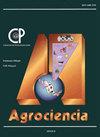DETECTION OF Acidovorax citrulli IN WATERMELON SEEDLINGS IN HOPELCHÉN, CAMPECHE, MEXICO
IF 0.5
4区 农林科学
Q4 AGRICULTURE, MULTIDISCIPLINARY
引用次数: 0
Abstract
In Mexico, there are no reports of the presence of Acidovorax citrulli, the causal agent of bacterial fruit blotch and seedling blight in cucurbits. The introduction of A. citrulli is a latent risk due to the importation of seeds and seedlings. Fruits and plants with typical symptoms of this disease have been observed in watermelon (Citrullus lanatus) production fields of small growers and commercial nurseries in the municipality of Hopelchén, Campeche. The objective was to detect A. citrulli by PCR in watermelon seedlings in a production area in Hopelchén, with the hypothesis that the bacterium is present in this municipality. In December 2018, 51 samples of nine watermelon varieties were collected from two seedling production nurseries. Each sample contained ten symptomatic seedlings ranging in age from 12 to 41 days. End-point PCR analysis with primers WFB1 and WFB2 indicated the presence of A. citrulli in 68.6 % of the samples; immuno-PCR results confirmed the presence of the bacterium in 80.9 % of these samples. Consensus 16S rRNA gene fragment sequences from eight samples aligned with 98 % similarity on average to A. citrulli sequences deposited in the GenBank-NCBI database. The dark, sunken, elongated lesions on cotyledonal leaves, as well as the black, spreading lesions from the margin to the base of true leaves observed on watermelon seedlings, were caused by A. citrulli. This study constitutes a new report of A. citrulli in Campeche, which should be considered to delimit and prevent the spread of the bacterium to other cucurbit-producing areas in Mexico.墨西哥坎佩切市HOPELCHÉN地区西瓜幼苗中瓜酸弧菌的检测
在墨西哥,没有关于葫芦细菌性果斑病和幼苗枯萎病的致病因子Acidovorax citrulli存在的报告。瓜蒌种子和幼苗的进口是瓜蒌引进的潜在风险。在坎佩切州hopelchsamin市的小型种植者和商业苗圃的西瓜(Citrullus lanatus)生产田地中,已观察到具有这种疾病典型症状的水果和植物。目的是通过PCR在hopelch郁闷产区的西瓜幼苗中检测瓜芽孢杆菌,假设该细菌存在于该市。2018年12月,从两个育苗苗圃采集了9个西瓜品种的51个样品。每个样品含有10株龄在12 ~ 41天的有症状幼苗。引物WFB1和WFB2的终点PCR分析表明,68.6%的样品中存在瓜螺;免疫pcr结果证实80.9%的样本中存在该细菌。来自8个样本的16S rRNA基因片段序列与GenBank-NCBI数据库中保存的A. citrulli序列的平均相似性为98%。在西瓜幼苗上观察到的子叶深色凹陷细长病变,以及真叶边缘向基部蔓延的黑色病变,都是由瓜霉引起的。本研究为坎佩切市发现瓜蚜杆菌的新报道,对确定和防止该菌向墨西哥其他产瓜区传播具有重要意义。
本文章由计算机程序翻译,如有差异,请以英文原文为准。
求助全文
约1分钟内获得全文
求助全文
来源期刊

Agrociencia
农林科学-农业综合
CiteScore
0.50
自引率
33.30%
发文量
51
审稿时长
18-36 weeks
期刊介绍:
AGROCIENCIA is a scientific journal created and sponsored by the Colegio de Postgraduados. Its main objective is the publication and diffusion of agricultural, animal and forestry sciences research results from mexican and foreign scientists. All contributions are peer reviewed. Starting in the year 2000, AGROCIENCIA became a bimonthly and fully bilingual journal (Spanish and English versions in the same issue). Since 2007 appears every month and a half (eight issues per year). In addition to the printed issues, the full content is available in electronic format.
 求助内容:
求助内容: 应助结果提醒方式:
应助结果提醒方式:


